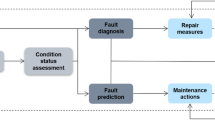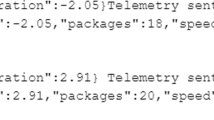Abstract
This article provides an application of the total productive maintenance (TPM) philosophy as a systematic means for avoiding losses and increasing productivity in an auto-parts machining line. This is achieved by strategically implementing the pillars of TPM on the basis of failure data, then performing a thorough “root cause analysis” thereof (targeted improvement). Preventive maintenance plans and the empowerment of the autonomous maintenance program operator teams become the main pillar in the implementation of this new philosophy as a result. All this is done with the full support of the general management and each area of the organization in order to guarantee the full implementation and sustainability of the program.
Similar content being viewed by others
References
Botero A. M., Cañon, A. B., Olarte C. W. (2010). Importancia del mantenimiento industrial dentro de los procesos de producción. Scientia Et Technica, XVI, 354–356
Glock CH (2013) The machine breakdown paradox: how random shifts in the production rate may increase company profits. Comput Ind Eng 66(4):1171–1176. doi:10.1016/j.cie.2013.07.018
Martínez RM, Marín-García JA (2013) Barreras y facilitadores de la implantación del TPM. Intangible Capital 9:823–853
Marria P, Williams SJ, Naim M (2014) Six S: creating an efficient and safer work environment. Total Quality Management & Business Excellence 25(11–12):1410–1428
Warwood SJ, Knowles G (2004) An investigation into Japanese 5-S practice in UK industry. TQM Magazine 16(5):347–353
Kareem JA, Talib NA (2015) A review on 5S and total productive maintenance and impact of their implementation in industrial organizations. Adv Sci Lett 21(5):1073–1082
Yasukawa K, Brown T, Black S (2014) Disturbing practices: training workers to be lean. J Work Learn 26:392–405. doi:10.1108/JWL-09-2013-0068
Foon SW, Terziovski M (2014) The impact of operations and maintenance practices on power plant performance. J Manuf Technol Manag 25(8):1148–1173. doi:10.1108/JMTM-12-2012-0122
Daneshjo, N., & Beke, P. (2016). Determination of diagnostic action intervals for planned interval maintenance. Advances and Trends in Engineering Sciences and Technologies—Proceedings of the International Conference on Engineering Sciences and Technologies, ESaT 2015, (págs. 257–262). Obtenido de www.scopus.com
César, F. I., Lima, C. R., & Simon, A. T. (2014). TPM implementation in its autonomous maintenance phase: case study in a food industry. [Implantação de tpm em sua fase manutenção autônoma: Estudo de caso em uma indústria de alimentos]. Espacios, 35(12). Obtenido de www.scopus.com
Singh K, Ahuja IS (2015) An evaluation of transfusion of TQM-TPM implementation initiative in an Indian manufacturing industry. J Qual Maint Eng 21(2):134–153. doi:10.1108/JQME-04-2013-0017
Jasiulewicz-Kaczmarek M (2014) Integrating safety, health and environment (SHE) into the autonomous maintenance activities. Communications in Computer and Information Science 345(2):467–472. doi:10.1007/978-3-319-07854-0_81
Jain AB, Singh H (2014) Total productive maintenance (TPM) implementation practice: a literature review and directions. International Journal of Lean Six Sigma 5(3):293–323. doi:10.1108/IJLSS-06-2013-0032
Assid, M., Gharbi, A., & Hajji, A. (2015). Production planning and opportunistic preventive maintenance for unreliable one-machine two-products manufacturing systems. IFAC Proceedings Volumes (IFAC-PapersOnline), 48, págs. 478–483. Ottawa. doi:10.1016/j.ifacol.2015.06.127
Chiarini A (2015) Improvement of OEE performance using a lean six sigma approach: an Italian manufacturing case study. International Journal of Productivity and Quality Management 16(4):416–433. doi:10.1504/IJPQM.2015.072414
Fonseca-Junior M, Holanda-Bezerra U, Cabral-Leite J, Reyes-Carvajal TL (2015) Maintenance management program through the implementation of predictive tools and TPM as a contribution to improving energy efficiency in power plants. Programa de gestión de mantenimiento a través de la implementación de herramientas predictivas y de TP. DYNA 92(194):139–149. doi:10.15446/dyna.v82n194.47642
Author information
Authors and Affiliations
Corresponding author
Rights and permissions
About this article
Cite this article
Morales Méndez, J.D., Rodriguez, R.S. Total productive maintenance (TPM) as a tool for improving productivity: a case study of application in the bottleneck of an auto-parts machining line. Int J Adv Manuf Technol 92, 1013–1026 (2017). https://doi.org/10.1007/s00170-017-0052-4
Received:
Accepted:
Published:
Issue Date:
DOI: https://doi.org/10.1007/s00170-017-0052-4




